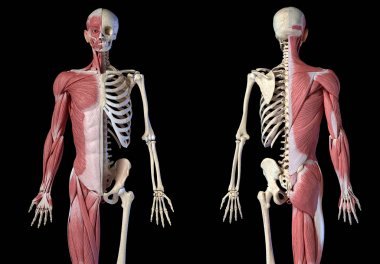Muscles, bones, joints, ligaments and soft tissues are the main parts that make up the body’s musculoskeletal system.
As we grow older day by day, all the parts that make up our musculoskeletal system will begin to wear out, muscle mass will show sarcopenia.
Sarcopenia is the loss of muscle mass, which is replaced with stiff, fibrous tissue, the bones will begin to lose their calcium, and the fluid that serves as a lubricant in the joint will also begin to decrease.
This is why we see so many elderly people who can’t walk or do some of the movements they can do in their younger years.
To function well, to maintain a healthy body, proper care and treatment is essential. This article will cover useful information on how to maintain this important part of the human body, even as you age, you will still be a little better than those who didn’t do any of the tips below.
How to keep your musculoskeletal system healthy
Exercise
Aerobic exercise has many benefits, from maintaining heart health to increasing lung capacity to lowering cholesterol and blood pressure.
From anaerobic exercise, it is also important to maintain bone density, improve muscle strength and endurance, and help prevent osteoporosis.
A good exercise routine will help enjoy good general health, all while helping you maintain a healthy musculoskeletal system.
Strength or resistance training is also good for the musculoskeletal system.
Regular exercise challenges you to Resistance to weight or use helps maintain healthy bones, joints and muscles.
Proper nutrition
Excessive intake of saturated fat has been linked to high blood pressure in both men and women. moderate consumption has not been associated with this condition.
A diet that maintains a good amount of protein and calcium is important for preventing conditions such as osteoporosis and osteoarthritis.
Fiber, potassium and water are also important for overall health. a good diet maintains these conditions.
You must also eat foods rich in vitamin D, such as eggs, oily fish, mushrooms, mackerel, salmon and milk.
Get enough rest and sleep
Most people don’t know that getting enough rest and sleep is vital to maintaining a healthy musculoskeletal system.
You see, when we sleep, our bodies have the opportunity to repair and rebuild muscle tissue, which is essential for maintaining muscle strength and preventing injury.
In addition, sleep is important for regulating hormone levels, including those involved in bone health and muscle growth.
So, without adequate rest and sleep, our bodies may not be able to fully recover from physical activity, which can lead to muscle fatigue, weakness, and even injury.
Basically, lack of sleep can lead to increased inflammation and decreased pain tolerance, making it harder for muscles and joints to recover from daily wear and tear.
Hydration
Dehydration can have many negative effects on the body, including constipation.
Staying hydrated is essential to maintaining muscle and joint health. Water helps lubricate the joints, reducing friction and wear.
It also helps transport nutrients to cells and remove waste products. Dehydration can lead to muscle cramps and joint pain.
To add to this, it is important to stay properly hydrated to avoid the discomfort of this condition as well as the risks associated with other health problems such as high blood pressure and diabetes.
Research at American Journal of Clinical Nutrition shows that even mild dehydration can impair physical performance and increase the risk of muscle cramps.
Thus, drinking plenty of water will help maintain a healthy musculoskeletal system, while also preventing many other health conditions. Therefore, you should always stay hydrated.
Supporting factors
In the case of arthritic conditions, one should always take a supportive approach.
The body functions as a whole and is not simply the sum of its parts. health must be maintained with appropriate supportive factors.
One must maintain adequate protein levels in addition to hydration and a proper diet to prevent disease.
Maintain good posture
Failure to maintain good posture, over time, can lead to long-term negative effects on the musculoskeletal system.
Maintaining proper posture will ensure that your spine is not angled to either side of your body or deviated along any of its natural curves.
Good posture also relieves muscle tension and prevents joint pain.
Simply put, maintaining good posture helps distribute weight evenly throughout the musculoskeletal system, reducing strain on muscles and joints.
Poor posture can lead to muscle imbalances, back pain and joint problems.
A study found that maintaining good posture can significantly reduce musculoskeletal pain and improve overall function.
Preventive treatment
Treatments for diseases such as arthritis or osteoporosis are important when it comes to maintaining a healthy musculoskeletal system.
A good doctor will be able to prescribe the right treatment for conditions like this so that you can enjoy your life as you should, while also benefiting from improved general health.
Spend time outside
Spending time outside is not only good for the mind and soul, but it can also do wonders for the musculoskeletal system.
Fresh air and sunlight can help increase levels of vitamin D, which is essential for strong bones.
First, being outside encourages physical activity, whether it’s walking, hiking, or playing a sport.
These activities can help build and maintain muscle strength, which is vital for a healthy musculoskeletal system.
Additionally, spending time outside can reduce stress levels, which can have a positive impact on overall health and well-being.
So, the next time you have the opportunity to spend time outdoors, take advantage of it and give your musculoskeletal system a boost!
Conclusion
The musculoskeletal system consists of bones, muscles, tendons, ligaments and soft tissues. They all work together to support your body weight and aid in movement.
You can avoid injury, disease, pain, stiffness and other problems with movement and function by keeping your musculoskeletal system healthy.
In addition, avoid smoking and reduce alcohol consumption. This is because smoking and heavy drinking can make your bones thinner.
Please follow and like us:
